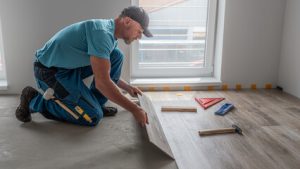
Flooring is one of the most impactful elements of interior design, shaping the look, feel, and functionality of every room. Beyond aesthetics, the right flooring provides durability, comfort, and safety, making it a crucial aspect of any home or commercial space. From hardwood and tile to vinyl and carpet, flooring options offer a wide variety of styles and performance features, allowing homeowners to create spaces that reflect their personality and meet practical needs. Understanding flooring options and installation techniques helps ensure long-lasting results and a visually appealing environment.
One of the most classic flooring choices is hardwood. Hardwood flooring is celebrated for its natural beauty, durability, and timeless appeal. Each plank showcases unique grain patterns and tones, adding warmth and character to any space. Hardwood is suitable for living rooms, bedrooms, and dining areas, offering a versatile and elegant solution that complements both traditional and modern décor. Regular maintenance, including refinishing and polishing, preserves its natural luster, ensuring that hardwood floors remain a long-lasting investment.
Tile flooring is another popular option, known for its versatility and durability. Available in ceramic, porcelain, and natural stone, tiles provide a wide range of colors, patterns, and textures. Tile is particularly well-suited for areas exposed to moisture, such as bathrooms, kitchens, and entryways, as it is resistant to water and easy to clean. Installation techniques, including proper grouting and sealing, are crucial for ensuring longevity and preventing water damage. Tiles also offer creative possibilities, with mosaics and patterned layouts adding visual interest and a sense of artistry to the floor.
Vinyl flooring has gained popularity for its combination of affordability, durability, and aesthetic appeal. Modern vinyl options can mimic the look of natural wood, stone, or tile while providing a softer and more resilient surface. Vinyl is easy to install, maintain, and clean, making it an ideal choice for high-traffic areas and households with children or pets. Its moisture resistance and comfort underfoot make it suitable for kitchens, bathrooms, and basements. Additionally, vinyl flooring is available in a variety of formats, including sheets, planks, and tiles, offering flexibility in design and installation.
Laminate flooring offers another durable and cost-effective alternative that replicates the appearance of hardwood or stone. Constructed from layered synthetic materials, laminate is resistant to scratches, stains, and fading, making it ideal for busy households. Proper underlayment ensures comfort and sound absorption, while floating installation techniques simplify the process for DIY enthusiasts. Laminate flooring combines practicality with aesthetic appeal, providing a high-end look without the maintenance requirements of natural materials.
Carpet flooring remains a favorite for its warmth, softness, and sound-absorbing qualities. Carpets are available in a wide range of textures, colors, and patterns, allowing homeowners to add personality and comfort to bedrooms, living rooms, or other cozy spaces. Carpeting also provides insulation, reducing heat loss and creating a comfortable surface during colder months. Regular vacuuming and occasional deep cleaning preserve the carpet’s appearance and extend its lifespan, ensuring a comfortable and inviting environment.
Safety and maintenance are important considerations when selecting flooring. Smooth, non-slip surfaces, cushioned underlays, and proper installation techniques contribute to safer spaces, reducing the risk of falls and injuries. Easy-to-clean surfaces save time and effort, while durable materials minimize the need for frequent repairs or replacements. Choosing the right flooring based on usage, moisture levels, and foot traffic ensures a balance between beauty, functionality, and longevity.
Flooring can also enhance the overall atmosphere of a home through color, pattern, and texture. Light-colored floors can make rooms feel larger and brighter, while darker tones add warmth and sophistication. Patterns, such as herringbone, chevron, or geometric designs, create visual interest and can complement other design elements in the space. Textured surfaces, including embossed tiles or hand-scraped wood, add depth and tactile appeal, making the flooring not only functional but also a statement piece within the interior design.
Installation techniques are a critical aspect of achieving a professional finish. For hardwood, proper acclimation, subfloor preparation, and precise nailing or gluing methods prevent warping and ensure stability. Tile requires accurate measuring, leveling, and grouting to maintain durability and prevent water intrusion. Vinyl and laminate floors often use click-lock or adhesive methods for seamless installation. Professional installation or careful adherence to guidelines ensures that flooring remains safe, durable, and visually attractive for years to come.
Sustainability is another important consideration in modern flooring choices. Many materials, such as engineered wood, bamboo, and recycled tiles, offer environmentally friendly alternatives. Choosing sustainable flooring reduces environmental impact while still providing the durability and aesthetic qualities homeowners desire. Additionally, low-VOC finishes and adhesives improve indoor air quality, creating a healthier living environment. Sustainable flooring allows homeowners to enjoy beautiful, functional spaces while contributing to responsible environmental practices.
Flooring upgrades can significantly increase the value and appeal of a home. A thoughtfully chosen floor enhances curb appeal and creates a lasting impression for visitors, potential buyers, or guests. Whether remodeling a single room or renovating an entire property, investing in quality flooring ensures both practical benefits and a visually cohesive, stylish result. Modern trends emphasize blending durability with elegance, offering a wide array of options to suit every taste and lifestyle.
In closing, flooring is a vital element of home design that combines aesthetics, comfort, and practicality. Options like hardwood, tile, vinyl, laminate, and carpet each offer unique advantages, allowing homeowners to tailor spaces to their needs and preferences. Proper installation, maintenance, and thoughtful selection of materials ensure that flooring remains durable, safe, and visually appealing. By considering factors such as style, functionality, sustainability, and installation techniques, homeowners can transform their spaces with flooring solutions that elevate both comfort and design. A well-chosen floor not only enhances the beauty of a home but also contributes to a more enjoyable and functional living environment for years to come.